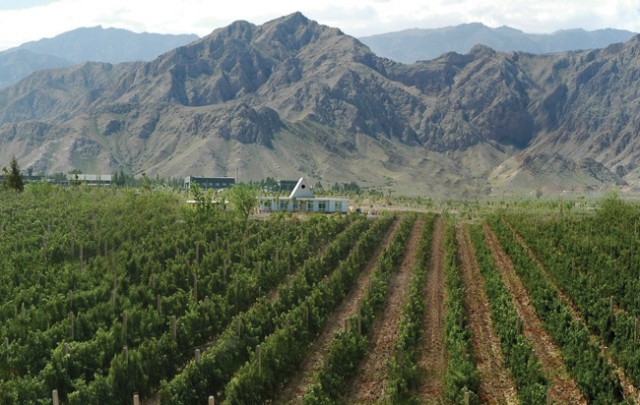Date£º
2014-11-03 11:09 Source£º
thedrinksbusiness Author:
Rupert Millar Translator:
Berry Bros & Rudd's Jasper Morris MW has revealed his thoughts on Ningxia Province in China as a potential fine wine region of the future.

Vineyard in Ningxia
Morris was in the region earlier this month and recently put down his opinions of the region from its climatic conditions to the varieties grown there and some of the difficulties that need to be overcome for it to truly begin to flourish.
Beginning with the climate he noted: "It hardly ever rains here: perhaps 200mm per year. Given that Helan Mountain provides the border between Ningxia and Inner Mongolia, it is no surprise to find a strongly continental climate with hot sunny summers and severely cold winters."
With an altitude of 1,000 metres above sea-level, he also said the region enjoys close to 3,000 hours of sunshine a year though with the harvest in October usually only just missing the first frosts, "there seems to be just enough hang time to ripen the grapes but with current viticultural practices, it is a close run thing."
It is the weather that provides perhaps the biggest impediment to Ningxia's progress. Chief among the difficulties is countering the extremes of heat and cold such as the need to bury the vines during winter, a process which kills a certain percentage of the vines each time, leading to constant replanting and ensures a proportion of the wine will always be from young vines ?and is particularly irksome if the vine that dies is an old one.
He describes the process: "The classic viticultural strategy here is for vertical shoot trellising forming a thinnish straggling canopy reaching nearly two metres. In winter, after pruning, the vines are laid flat and the sandy soil which has been piled in between the wide spaced rows is spread to cover the vines through the long cold winter.
"This is labour intensive and probably reduces the life of the vine as a percentage do not survive. It is also very difficult to do in those locations, such as Chateau Yunmo, where there is a much greater percentage of stones in the otherwise sandy soil ?certainly there were many more gaps in the vineyard here."
He reported that Domaine Chandon -which recently released its first vintage -have followed a more traditional, French pattern of planting while others are looking for alternatives to burying the vines.
"If Ningxia is going to prove to be a region of world class potential,¡°he commented, "a breakthrough is needed somewhere along the line."
Heat brings its own troubles too, with irrigation required but rather than the "subtle"drip irrigation used elsewhere, in Ningxia vineyards are simply flooded, which in turn can lead to high yields and a diluted and "noticeable"green streak in some wines.
On the other hand, "the significant diurnal swing between the heat of the day and the cool of the night is beneficial to quality, and the lack of humidity is good protection against disease, though some of the vine stock, especially Cabernet Gernischt, is apparently infected by virus which may also retard ripening."
Interestingly, among the Bordeaux varieties that are unsurprisingly the most popular, Morris discovered that a lot of Cabernet Gernischt is in fact ?Carmenere. Not the first time that variety has cropped up under the guise of another.
Morris noted that some Pinot Noir and Syrah was being experimented with but pondered if Tempranillo might not be a better fit in the arid landscape of the region.
In terms of the region's future Morris concluded thus. If the next move is to export overseas and be recognised as China's leading wine region then, "there is a fair amount of fine tuning to be done."
"At the moment there is an imbalance between the quality of the fruit which makes up the raw material, and the ambition of the region to be China's premium wine production area."
At their best though, the wines show promise. He continued: "Lower yields (as the best already practice), ripe and balanced fruit, aiming to attain the cusp between red and black notes while avoiding green flavours, more restrained oaking and a more harmonious approach to presentation should all be achievable within the next five to 10 years."